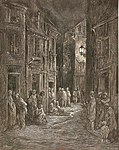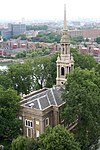Shadwell & St. George's East railway station
Shadwell was a railway station in the parish of St. George in the East, London, that was opened by the Commercial Railway (later the London and Blackwall Railway). It was situated 50 yards to the east of the current Shadwell DLR station on the Docklands Light Railway, with the former station entrance on Sutton Street (Shadwell DLR's entrance is on Watney Street). The former station was between Cannon Street Road and Stepney (now called Limehouse), and was 1 mile 5 chains (1.7 km) down-line from Fenchurch Street.Shadwell opened in October 1840, three months after the opening of the rest of the Commercial Railway, which rebranded as the LBR in 1841. It was eventually incorporated into the London, Tilbury and Southend Railway (LTSR) and was rebuilt in 1895 when the railway was widened to four tracks; Shadwell only served the slow lines on the south side. In 1900, the station was renamed Shadwell & St. George's East, possibly to distinguish it from the East London Railway (ELR) station of the same name. Apart from a wartime closure between 1916 and 1919, Shadwell & St. George's East remained open until July 1941, when dwindling passenger numbers forced its then owner, the London and North Eastern Railway, to close both it and Leman Street station. Some remains of the station can still be seen today: the westbound platform has partially survived although it is somewhat dilapidated, and the red brick station entrance on Sutton Street still survives. The Docklands Light Railway Shadwell station has been built partly on the site of the station.
Excerpt from the Wikipedia article Shadwell & St. George's East railway station (License: CC BY-SA 3.0, Authors).Shadwell & St. George's East railway station
Shadwell Place, London Shadwell
Geographical coordinates (GPS) Address Nearby Places Show on map
Geographical coordinates (GPS)
| Latitude | Longitude |
|---|---|
| N 51.5119 ° | E -0.0544 ° |
Address
Shadwell Platform 1
Shadwell Place
E1 2QB London, Shadwell
England, United Kingdom
Open on Google Maps








